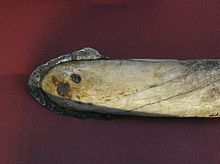Narwhal, Monodon Monoceros, is a medium-sized toothed whale that lives year-round in the Arctic. One of the two species of whales that live in the family Monodontidae with belugas, narwhal males are distinguished by a characteristic of the defense long, straight, helical, extending his left upper jaw. It is mainly found in the waters of the Canadian Arctic and Greenland, rarely south of 65 ° north latitude, the narwhal is a uniquely specialized Arctic predator. In winter, feeding on benthic prey, mostly flatfish, at depths of up to 1,500 meters below the ice density. Narwhal were collected over a thousand years by the Inuit of northern Canada and Greenland, meat and ivory, and regulation of subsistence hunt continues to this day. While populations appear stable, the narwhal was considered particularly vulnerable to climate change due to a narrow range of geographic and specialty foods.
Taxonomy And Etymology :
Narval was one of the many species originally described by Linnaeus in his Systema Natura. Its name is derived from the Old Norse word da, meaning "equal", referring to the animal grayish, mottled pigmentation, like that of a drowned sailor The scientific name Monodon monoceros, comes from the Greek :. "One-tooth one-horn"or "one-tooth unicorn."
Narwhal is more closely associated with the beluga whale. Together, these two species are the only surviving members of the family Monodontidae, sometimes called "white whales". Monodontidae is characterized by a medium-sized (3-5 feet), melons forehead, short muzzle, and without a true dorsal fin., white whales, dolphins (Delphinidae) and porpoises (Phocoenidae) together form a superfamily Delphinoidea, which can be monophyletic in origin. Genetic evidence suggests the most closely related to whales, porpoises, and that these two families form a distinct branch, which differs from Delphinoidea in the last 11 million years.
 |
| Narwhals |
Narwhals have a diet relatively small and specialized. Their prey is mostly composed of Greenland halibut, polar and Arctic cod, shrimp and squid Gonatus. Other items found in stomachs included the wolf, capelin, skate eggs and sometimes rocks, accidentally ingested when whales feed near the bottom.
Narwhals exhibit seasonal migration, with great fidelity to return to summer favorite ice motifs, usually in shallow water. In winter, mainly offshore, in deeper water under the thick layer of ice surfaces in narrow crevices in sea ice, or conduit. The narwhals in Canada and West Greenland winter regularly in the pack ice of Davis Strait and Baffin Bay along the continental slope with water to less than 5% open and strong black halibut densities. Feeding in winter accounts for a much larger proportion of narwhal energy intake in summer and, as marine predators, which are unique in their successful exploitation of Arctic ecosystems deep water.
 |
| Narwhals |
Narwhals normally congregate in groups of five to ten people. In summer, many groups come together, forming large aggregations. At times, male narwhals rub their tusks together in an activity called "tusking." This behavior is thought to maintain social hierarchies of domination.
Population And Distribution :
The narwhal is found mainly in the Atlantic and Russian Arctic Ocean. Individuals are generally recorded in the northern part of Hudson Bay, Hudson Strait, Baffin Bay, off the east coast of Greenland, and a tread is the northern tip of Greenland Round-eastern Russia (170 ° F). Land in this strip includes Svalbard, Franz Josef Land and Severnaya Zemlya. observations north of narwhal have occurred north of Franz Josef Land, about 85 degrees north latitude.
The world population is currently estimated at around 75 000 individuals. Most of the world's narwhals are concentrated in the bays and fjords in northern Canada and West Greenland.
Narwhals are a migratory species. In summer, close to shore, usually in pods of 10-100. As the winter freeze begins, they move away from the shore, and reside in the dense ice, surviving in leads and small holes in the ice. As spring comes, these tracks in the channels and the narwhals return to the coastal bays.
People And Narwhals :
In Inuit legend, defending the narwhal was created when a woman with a rope attached to the spear around his waist was dragged into the sea after the harpoon had reached a large narwhal. It became a common narwhal, and her hair, wearing a twisted knot, became the characteristic spiral narwhal tusk tusk.Some medieval Europeans believed narwhal the legendary unicorn horns.As these horns are believed to have magical powers, like the ability to cure poison and melancholia, the Vikings and other northern traders were able to sell several times their weight in gold. The tusks were used to make cups that were thought to negate any poison that may have been dropped in the drink. During the 16th century, Queen Elizabeth received a narwhal tusk sculptures and jewelry of £ 10,000 cost of a castle (from 1.5 to £ 2.5 million in 2007, using the index of retail prices). The tusks were staples of the cabinet of curiosities.
The origin of truth lobe developed gradually during the Age of Exploration, as explorers and naturalists began to visit Arctic regions themselves. In 1555, Olaus Magnus published drawing of the fish creature with the horn on the forehead, correctly identify the "Narwal".Narwhal was one of two possible explanations for this phenomenon is a giant of the Sea by Jules Verne in his book Twenty Thousand Leagues Under the Sea. Another explanation was the beginning of man but is not likely to consider the narrator.
Herman Melville wrote in Moby Dick Narwhal section, which states Narwhal tusk hung for "long" in Windsor Castle after Sir Martin Frobisher had given to Queen Elizabeth.













0 comments
Post a Comment